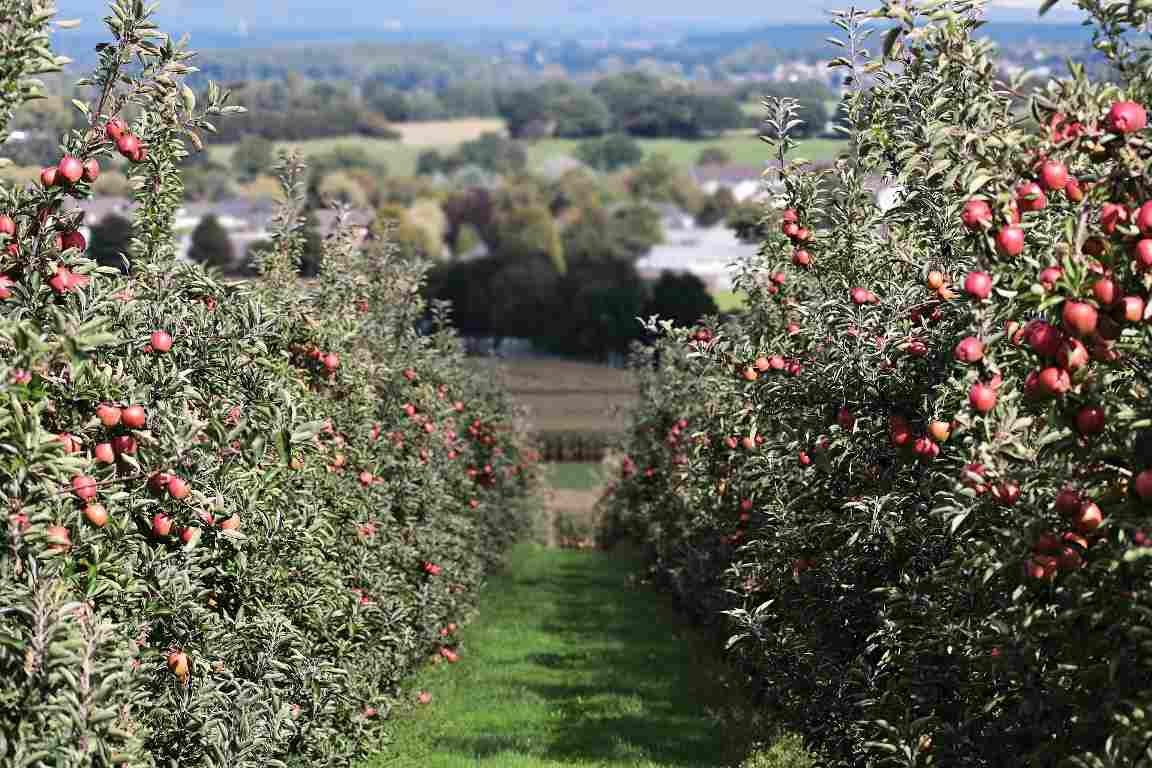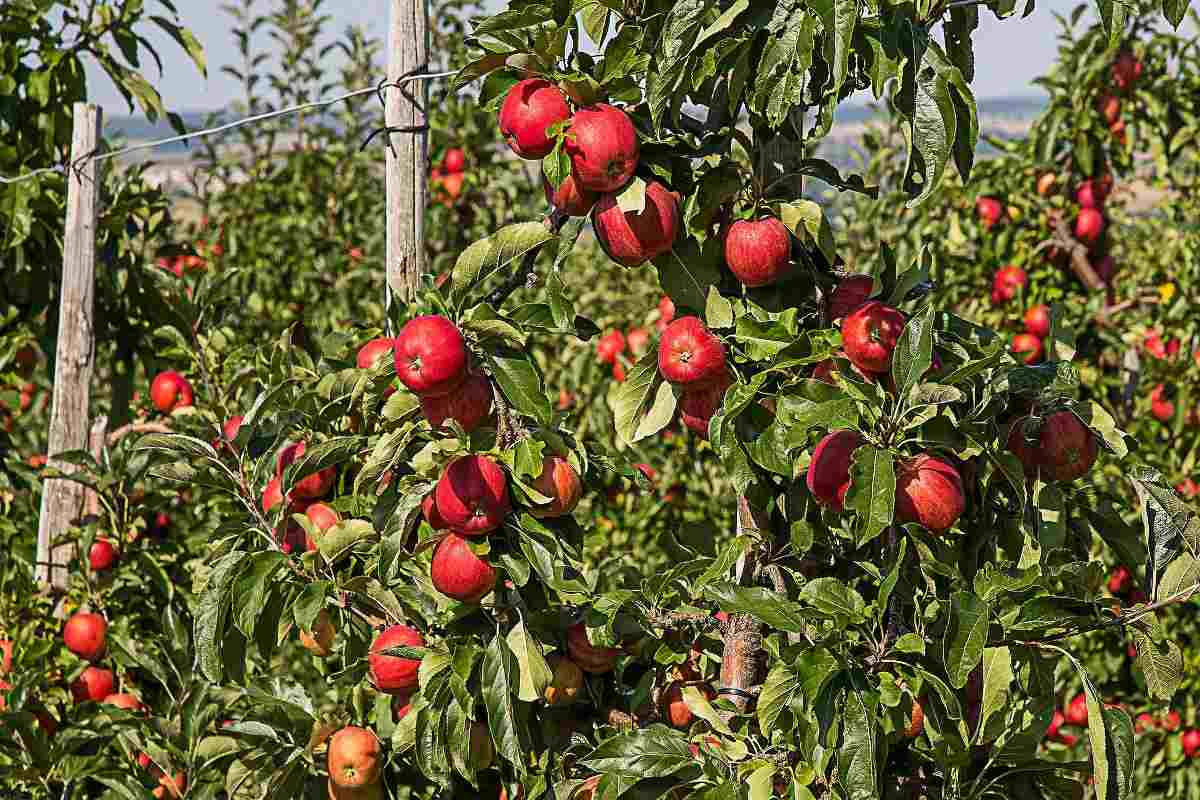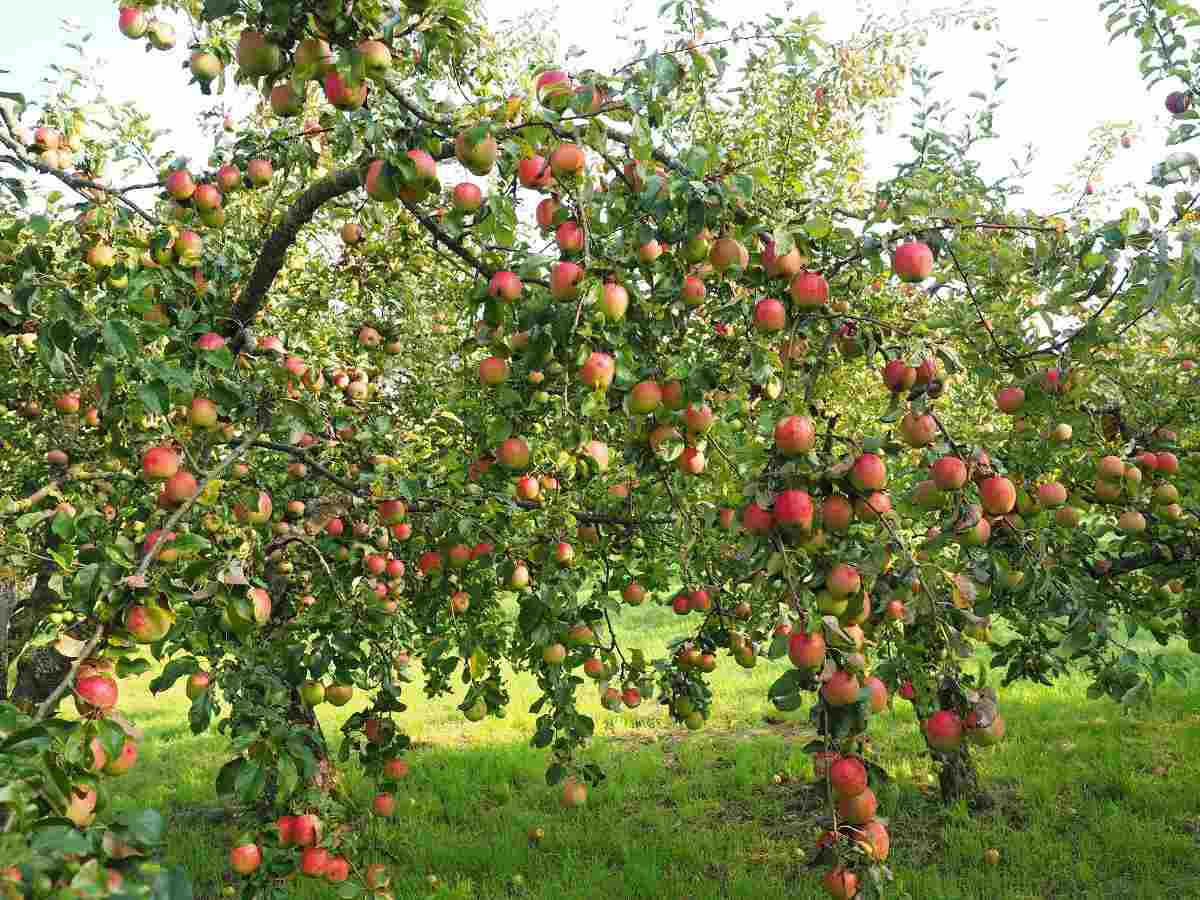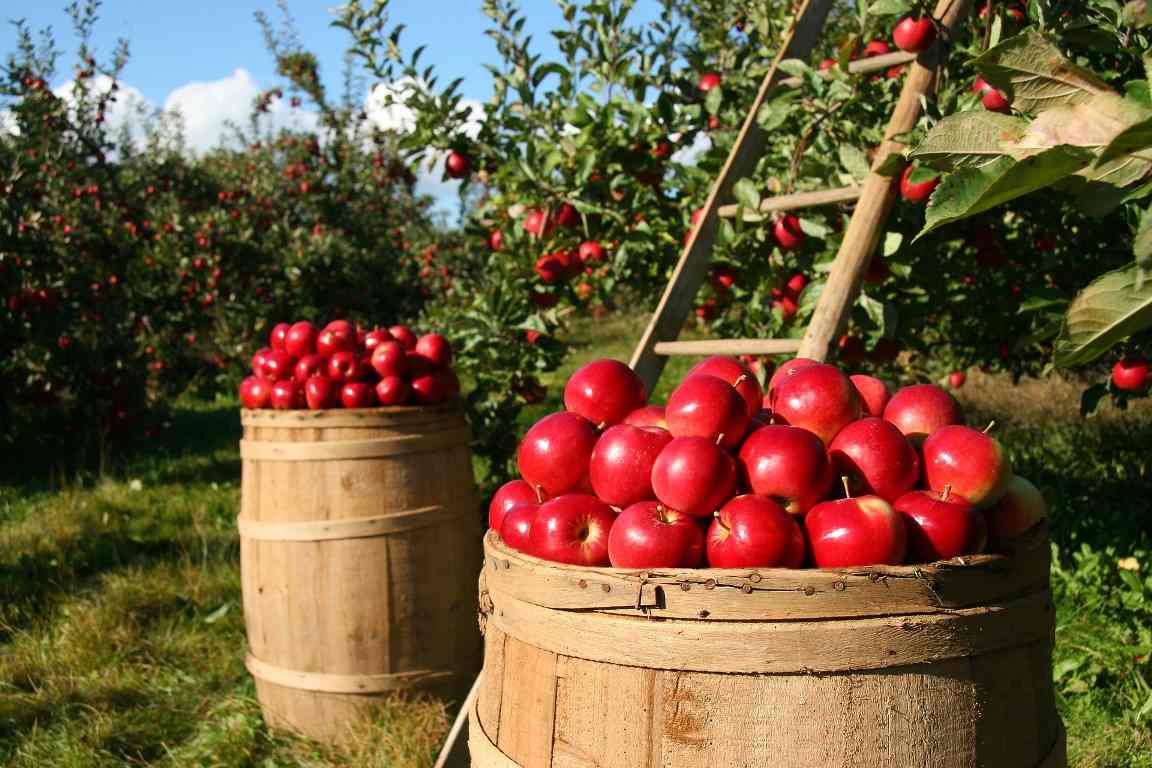High Density Apple Farming
An Apple is an edible fruit produced by an Apple tree and it’s scientifically called Malus Domestica. Apple is commercially the most important temperate fruit in India. The largest Apple producing country in the world is China. Apple is the fruit of the domesticated tree and one of the most widely cultivated tree fruits. In this article we also covered the below topics about high density Apple farming;
- What is high density orchard
- Advantages of high density planting
- Is growing Apples profitable
- High density Apple plantation
- High density Apple orchard spacing
- What is a high density orchard
- High density Apple training systems
A Step by Step Guide to High Density Apple Farming and Production In India

High density planting (HDP) in fruit trees is to increase the plant population per unit area for increasing the production of fruit crops. It is also useful;
- To overcome low productivity and
- The long gestation period for early returns.
High density plantation mainly refers to the planting of the increased number of plants per unit area of land at close spacing, which is achieved by using suitable scion varieties grafted on dwarfing rootstocks. High density planting in Apple is done using dwarfing rootstocks (M9, M4, M7, and M106). The flower of most tree varieties requires cross-pollination for fertilization. When harvested, Apples are roundish, 2 to 4 inches in diameter, and some shade of red, green, or yellow; they vary in size, shape, and acidity depending on the tree variety.
High density Apple Cultivating in India
High-density plantation refers to the planting of the maximum possible number of plants per unit area to obtain maximum crop yield and profit per unit of tree volume without impairing the soil fertility status.
Apple is the important temperate fruit crop of the North-Western Indian Himalayan region. In India, Apple is cultivated in Kashmir, Himachal Pradesh, hills of Uttarakhand. Apple cultivation is also extended to Nagaland, Sikkim, Arunachal Pradesh, and Meghalaya.
India’s share in the total Apple production of the world is 2.0 %. The total area under Apple cultivation In India is 250 thousand hectares producing 1470 thousand MT fruit with a productivity of 5.9 tonnes/ha. In Jammu and Kashmir, the total area under Apple is about 90.1 thousand hectares with a production of 909.6 thousand MT. The state of Jammu and Kashmir leads the other Apple-producing states in India, in terms of productivity with the production of 10.1 MT fruits per hectare.
High Density Apple Orchard in Himachal
In Himachal Pradesh, farmers are currently in a fight to save their Apple tracts that have been hit hard by climate change. They are adopting the new method of high-density Apple plantation being promoted by the state government.
The high density plantation is aiming at an increase in both productivity and quality. Also, it will help farmers meet the challenge of scarcity of labor.
High density farming refers to the planting of a higher number of plants per unit area than usual. Conventionally, standard Apple plants raised on seedling rootstocks are planted at a spacing of about 7.5 X 7.5 meters with a planting density of 178 trees per hectare and spur varieties on seedling rootstocks are planted at a spacing of about 5 X 5 m with a planting density of 400 plants per hectare.
The average productivity of these orchards is about 6 to 8 metric tonnes per hectare, which is much below the productivity obtained in high-density orchards 40 to 60 MT per hectare. Also, high density orchards can be developed on flat and fertile lands too the technology helps utilize land, provide ease in orchard inter-culture operations, plant protection, harvesting, and obtaining export quality of the produce.
The several Apple varieties in high-density planting are Jeromine, Red Velox, Red Cap Valtod, Scarlet Spur-II, Super Chief, Gale Gala, Redlum Gala, and Auvil Early Fuji.
High Density Apple Varieties in Kashmir
The demand for high density Apple plantation has increased in Southern districts. Imported Apple varieties that yield more fruit, consume less fertilizer and pesticide is in greater demand in southern Kashmir. The government promotes high density plantations, phasing out old plantations that have completed their economic life, giving farmers a subsidy of 50% on this re-plantation.
Proper irrigation is vital for raising this type of plantation and may need a bore well facility and contrary to traditional plantations this setup needs a drip pattern of irrigation, proper sanitation, and frequent checkups. Under high density plantation, about 4000 plants can be planted per hectare which is 250 trees under traditional farming.
High density Apples consume 70% less fertilizer and 80% less pesticide spray, adding that these Apple trees produce about 50 to 70 tons of fruit per hectare by the third year of plantation while traditional varieties produce about 10 to 15 tons.
Principles of High Density Apple Production
- Types of Pesticides Used in Agriculture: A Beginner’s Guide
- Economical Aquaculture: A Guide to Low-Budget Fish Farming
- 15 Common Planting Errors That Can Doom Your Fruit Trees
- How to Make Houseplants Bushy: Effective Tips and Ideas
- Innovative Strategies for Boosting Coconut Pollination and Yield
- Pollination Strategies for Maximum Pumpkin Yield
- The Complete Guide to Chicken Fattening: Strategies for Maximum Growth
- Natural Solutions for Tulip Problems: 100% Effective Remedies for Leaf and Bulb-Related Issues
- Revolutionizing Citrus Preservation: Towards a Healthier, Greener Future

A high density orchard is defined as an orchard with more than 150 to 180 trees per acre. Though many highly productive commercial orchards today have 150 to 180 trees per acre and higher density can be anything over 180 trees per acre. There are several characteristics in addition to tree number that is included in a high density system. Besides having an increased number of trees per acre, a high density planting must come into bearing within 2-3 years after planting. To maximize the production of a high density planting, it is also necessary to modify the training system and training and pruning techniques from traditional methods. Since Apple trees will be bearing fruit early, a permanent tree support system is also required.
The control of excessive vegetative growth in the tree for increased productivity is the main principle of high density production.
- High early yields – high tree density
- Balance vegetative and fruiting
- Excessive vigor- Small crop yield, larger fruit, poor fruit color development
- Excessive Fruit Load-Large crop yields, Small Apples, Weak trees
With the advent of spur type cultivars and vigor controlling rootstocks, this system of planting is becoming popular in the case of Apple. High density Apple planting are precocious, easily manageable, has higher yield potential, with better quality fruits and higher returns/unit area. The high density Apple planting cannot be adopted in steep, unfertile, shallow, and drought-prone areas. The planting distance mainly depends upon the nature/vigor of the variety and the rootstock used.
Soil Requirement for High Density Apple Farming
- Apples grow best on well-drained, loam soils having a depth of about 45 cm and a pH level of pH 5.5-6.5. Soils with heavy clay soil or compact subsoil are to be avoided.
- Soils must be well-drained. Wet soils lead to poor aeration and increased incidence of crown rot in Apple trees. Normally, rooting tends to be shallow, and wet soils will restrict development, resulting in the poor anchorage of the tree and a reduced area of soil from which nutrients can be extracted.
- Minimum rooting depth of 4 to 5 feet is desirable. (Trees on shallow soils will be affected by drought and by root injury during extended severe cold spells.)
- Soil pH level and fertility can be adjusted and are not major considerations; highly fertile soils can cause excessive tree vigor and are not desirable.
Importance of Planting Density in Apple Trees
Planting density is the most important factor which determines the yield of an orchard for the first 5 years. However, tree quality has a large impact on early yield per tree.
We suggest for modern high-density Apple orchards that in-row spacing ranges from 3 to 5 feet and between row spacing from 10-14 ft. (780-1450 trees/acre). The planting distance changes according to variety and the fertility level of the soil. The main consideration in planting Apple trees is planting sufficient pollinators to ensure effective pollination. Usually, one pollinator tree is needed for 2 to 3 large trees planted at a 10 m distance or one-row pollinator for 2 rows of the main cultivar. For high density planting the pollinator, the tree is planted after every 6th tree in a row.
The most widely used planting system in Apple trees is the square system. In this system, the pollinators are planted after every 6th or 9th tree. The other system of planting is the rectangular system. In hilly areas, the Apple orchards are established by planting the Apple trees on the contours to prevent soil erosion and reduce runoff.
Rootstocks for High Density Apple Farming
High density planting requires trees propagated on dwarfing rootstocks. Presently, only three commercially available rootstock types can be recommended to develop a high density orchard system. Having small trees is not enough; the trees should bear fruit early in the life of the orchard. The Apple rootstocks that are commercially available to fit this niche are M.9, Bud.9, and M.26. No perfect rootstock exists, and the limitations and strengths of each rootstock should be evaluated to select the rootstock that performs best in a specific situation. Trees propagated on these Apple rootstocks for high density systems need to be supported and irrigation is strongly encouraged. Although only a few rootstocks are available for high density planting at present, several promising selections are under evaluation.
The main characteristics of commercially available dwarfing Apple rootstocks for high density planting;
Malling9 (M.9)
Advantages
- Very early bearing
- Moderately resistant to Phytophthora crown rot
- Very productive
- Very few suckers
Disadvantages
- Very susceptible to fire blight
- Poor anchorage
- Very susceptible to woolly Apple aphids
Budagovsky9 (Bud.9)
Advantages
- Very early bearing
- Very productive
- Resistant to Phytophthora crown rot
Disadvantages
- Very susceptible to fire blight
- Very susceptible to woolly Apple aphids
- Poor anchorage
Malling26 (M.26)
Advantages
- Early bearing
- Good productivity
- Fairly good anchorage
Disadvantages
- Extremely susceptible to fire blight
- Very susceptible to woolly Apple aphids
- Drought sensitive
- Moderate susceptibility to Phytophthora crown rot
Spacing or Planting Distance in High Density Apple Farming
The average number of plants in an area of one hectare can range between 200 to 1250. Standard Apple plants raised on seedling rootstocks are planted at a spacing of about 7.5 X 7.5 meters with a planting density of 178 trees/ha and spur varieties on seedling rootstocks are planted at a spacing of 5.0 X 5.0 m with a planting density of about 400 plants/ha. The average productivity of these orchards is about 6 to 8 MT/ ha, which is much below the productivity obtained in high-density orchards (40-60 MT/ ha).
In high-density planting, Apple plants on clonal rootstocks up to about 5,333 plants/ha can be planted to increase the production per unit area basis and improve the quality of the produce. High-density planting can be done on flat and fertile lands with assured irrigation using dwarf/semi-dwarf clonal rootstocks, which can be trained to modern methods of canopy management such as vertical axis, slender spindle, and tall spindle, etc. Canopy management has paramount importance in high-density planting to control the vigor of trees and harvest quality Apple fruits.
Planting Process in High Density Apple Farming
The successful management of Apple trees in a high-density planting system depends on maintaining a balance between vegetative growth and fruiting. The use of smaller than standard-sized trees of uniform shape in high-density plantings of from 200 to 500 or more trees per acre can be a solution to the problem of developing more efficient orchard operations. Apple trees in these plantings will require some type of size control, which can be accomplished in several ways a high density orchard is defined as an orchard with more than 150-180 trees per acre. Though many highly productive commercial orchards today have 150-180 trees per acre and higher density could be anything over 180 trees per acre.
The introduction of high-density Apple orchards may well be one of the important changes in Apple production practices. High-density planting will provide for an efficient operation with optimum utilization of the available labor force. Also, the advantage of high density plantings is that the orchard space can be rapidly filled, fruited, and then maintained by utilizing the early bearing and size controlling characteristics of certain stock scion combinations.
High-density planting should not be considered as a work-free system of producing fruits. The successful management of Apple trees in any high-density planting system mainly depends on maintaining a balance between vegetative growth and fruiting. For high yield and high fruit quality, the orchard system needs to combine both high light interception and good light distribution within the tree canopy. To maximize the production of a high density planting, it is necessary to modify the training system and training and pruning techniques from traditional methods. Since Apple trees will be bearing fruit early, a permanent tree support system is also required.
The traditional systems of planting have a long juvenile period, are labor-intensive and low crop yielding with poor quality fruits. Whereas high density planting is easily manageable, has higher yield potential, with better quality fruits and higher returns/unit area.
There are 4 categories of high density planting in Apple trees. They are;
- Low (less than 250 plants/ha)
- Moderate (250-500 plants/ha)
- High (500-1250 plants/ha)
- Ultra high density (more than 1250 plants/ha)
The trees have a maximum number of fruiting branches and a minimum number of structural branches.
Tree Size Control in High Density Apple Planting
In case if you miss this: Vegetable Farming Tips In India.

Successful high density Apple planting depends upon control over tree size. Following methods can be adopted;
- Use of size controlling rootstocks
- Use of spur type scions
- Training and pruning methods to induce dwarfing and spreading habits of the tree
- Mechanical devices like branch bending to control tree size
Irrigation and Fertigation in High Density Apple Planting
The irrigation requirements for Apple trees will change depending on the growth stage. Therefore it becomes imperative to determine the critical stages of irrigation for Apples. The pressurized micro irrigated high-density plantation orchards shall produce better quality and higher yielding Apple in comparison to the best Apple-growing areas of the world.
Modern Apple farming favors a high tree population and dense planting. Drip irrigation distributes water locally along narrow crop rows though keeping the surface between each row dry. Drip lines can be easily suspended on the trellising wire where it is kept from machinery or animal-related damage. By irrigating and fertigating throughout the growing period, you can be sure that Apples will have exactly what they need to reach their optimal size.
With a drip irrigation system, you control the uniform distribution of water and fertilizers, eliminating wind effects and evaporation from the soil surface.
Tree Support Systems in High Density Apple Farming
As Apple growers move to higher-density systems using more dwarfing rootstocks, tree support becomes more of a concern. Most of the very dwarfing rootstocks need support, but there are somewhat more vigorous rootstocks that can perform well without support under certain conditions. Depending on the cultivar, soil type, slope, vigor, and cropping conditions, support could be necessary for semi-dwarf stocks.
Support systems must be installed soon after planting. The cost of tree support systems varies widely. One system normally used is a single wire set at 9-10 feet off the ground and a 12-foot piece of conduit driven into the ground and then attached to the wire. In recent years the cost of conduit has risen to the point that growers are now looking at using 4 or 5 wires spaced about 1.5-2.0 feet apart as the support system.
Training and Pruning in High Density Apple Farming
- The growth of Apple trees is controlled primarily by bending side branches to the horizontal and securing them at that angle. This slows the growth of the Apple trees and makes them much more productive.
- Timely pruning and training operation in Apple trees is essential for proper crop growth and good productivity. The Apple plants are trained according to the growth habit and vigor of the rootstocks.
- Pruning is essential to maintain a proper balance between vegetative and spur development. Proper pruning of weak and undesirable branches/twigs is necessary after 6 years of plantation.
- Training and pruning are important horticultural practices of canopy architecture. The training aims at more penetration of sunlight support to main branches for desired tree architecture to increase the planting density and finally increasing crop production.
Pests and Diseases Control in High Density Apple Farming
Apple Pests
Codling moth, Plague thrips, Western flower thrips, Apple dimpling bug, European red mites, Two-spotted mites, Woolly Apple aphid, and Queensland fruit fly are some common pests commonly found in Apple cultivation.
Pests Control – To controlling these Apple pests, make use of suitable chemical fertilizers as a foliage spray. However, proper intercultural activities such as growing resistant rootstocks, spraying Chloropyriphos, fenitrothion, and carbaryl, etc have more effective results on Appletree pests control in commercial farming.
Apple Tree Diseases
Apple Scab, fruit blotch, Bitter rot, Powdery mildew, White root rot, Sclerotium collar rot, and Alternaria leaf, etc are the main diseases commonly found in Apple cultivation.
Apple Disease Control – For controlling Apple tree diseases, choose a quality and disease-resistant in growing Apples. It prevents most of the diseases. Though, removal of the infected plant and use of suitable chemical fertilizers like mancozeb, carbendazim, and other such fungicides has effective results.
When and How to Harvest Apples

Apples come to harvest from midsummer through late fall season; fruit ripens 100 to 200 days after fruit set depending on the tree variety. The best method to know if Apples are ready for harvest is to taste them; select one and try it. Also, consider fruit skin color and fruit drop. The Apple fruits mature within 130-150 days after the full bloom stage depending upon the variety grown. The color of the skin at maturity ranges from yellow-red depending on the tree variety. However, the optimum time of Apple harvest depends on fruit quality and the intended period of storage.
Yield in High Density Apple Farming
The present crop yield of traditional Apple is only 20 metric tons per hectare, while the high-density Apple breed yields about 40 to 60 metric tons of Apples per hectare.
Nice blog. Thanks for sharing such great information!
Thanks for sharing such beautiful information with us. I hope you will share some more info about the vegetable and flower seeds service. Please keep sharing!
We want to know about raising spur high density apple plants in flood prone areas of Bijbehara Kashmir
I am searching a professional consultants for establishing a Apple orchard in 500 acres. Please contact me at nine five four double one two zero double one three
Nice info, was looking for this. Thanks.
I am planning to start apple cultivation on 5 hectares land.Please kindly suggest me the reliable source of apple saplings of apple
I have a small piece of land measuring 24×400 feet, fertile land. I want to develop it into a high density apple orchard. How many rows can I plant ?